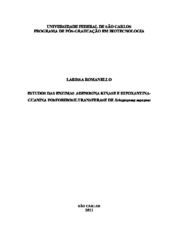Estudos das enzimas adenosina kinase e hipoxantina-guanina fosforibosiltransferase de Schistosoma mansoni
Abstract
Schistosoma mansoni is the parasite responsible for schistosomiasis mansonica, a disease that affects about 207 million people worldwide, and does not have the purine de novo sinthetic pathway, depending entirely on the purine salvage pathway to supply its demands on purines. Adenosine kinase (AK) and Hypoxanthine-guanine phosphoribosyltransferase (HGPRT) are important enzymes of the purine salvage, the AK directly phosphorylates adenosine into adenosine monophosphate (AMP) and HGPRT is responsible for the reversible phosphorybosylation of hypoxanthine or guanine into IMP or GMP. The purine salvage pathway has been reported as a potential target for developing new drugs against schistosomiasis. The nucleotide coding region of the isoform 2 of AK enzyme was amplified and cloned into pGEM vector and pET28a, the recombinant protein was expressed in E.coli BL21 (DE3), purified in a his-tag nickel-affinity resin and AMP-agarose resin, tested for its activity and crystallized. Two data sets were obtained by X-ray diffraction: a ternary complex of AK2-AMP-adenosine in the MX2 light line of the Synchrotron Light National Laboratory and a binary complex AK2-tubercidin in the rotatory anode X-ray source of the Institute of Physics at Sao Carlos - USP, both at 2.3A of resolution. The nucleotide coding region of the enzyme HGPRT was also amplified, cloned into pGEM and pET28a, which heterologous expression was done in E.coli BL21 (DE3) cells at 18°C and purified on a cobalt his-tag affinitiy resin.
